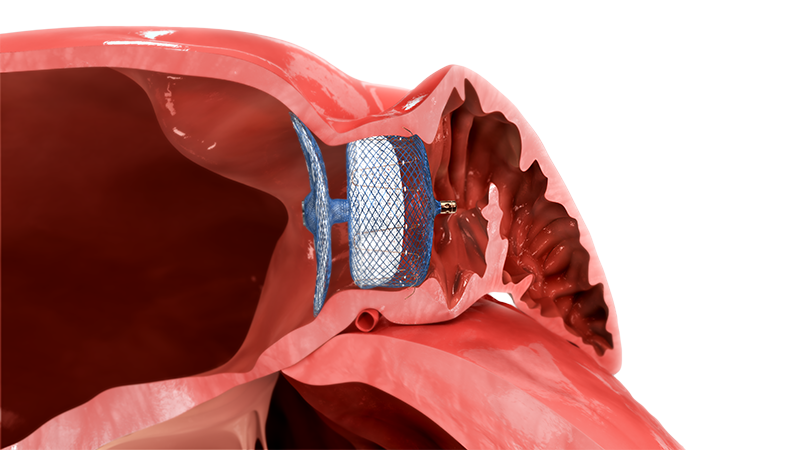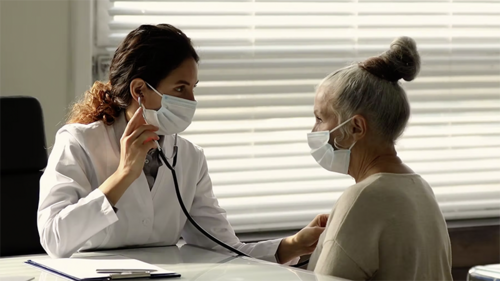Atrial Fibrillation (AFib) and Stroke
CAN ATRIAL FIBRILLATION CAUSE STROKE?
In Atrial Fibrillation (AFib), the top chambers of the heart quiver or flutter. This can cause blood to pool in the heart and form clots. When clots travel to the brain, they can cause a stroke. Most clots that lead to stroke are formed in an area of the heart called the left atrial appendage.1
What is a Left Atrial Appendage?
The left atrial appendage (LAA) is a muscular pouch connected to the left atrium of the heart. Every patient’s LAA is unique, in a wide range of shapes and sizes. The LAA is a normal part of the heart anatomy and causes no problems in the general population. However, for people with AFib, the LAA can be where the majority of clots form. A doctor may suggest Left Atrial Appendage Occlusion with the Amplatzer Amulet occluder.
What is the Amulet occluder?
The Amplatzer Amulet occluder is a small device about an inch long, that effectively seals off the LAA to prevent clots from escaping into the rest of the body. Highly trained physicians place the device during a short, non-surgical procedure. The Amplatzer Amulet occluder has been used successfully in Europe since 2013.

ADDITIONAL AFIB TREATMENT OPTIONS TO REDUCE STROKE RISK
Medical management
Anticoagulant medications help treat AFib by thinning the blood to reduce the risk of a clot forming. However, many people are not able take blood thinners due to:2

Increased risk of bleeding

Unpleasant side effects

Cost

The need for constant blood testing

Other medical conditions

Increased risk of bleeding

Unpleasant side effects

Cost

The need for constant blood testing

Other medical conditions
Catheter ablation
Cardiac ablation is a procedure in which a doctor will access the heart through a blood vessel. A catheter (a long steerable tube) will enter the vessel and be placed in the heart where diagnostic devices will be used to determine the area of the heart that needs to be treated. The doctor will use the catheter to apply energy to the targeted heart tissue. This will isolate the area from the rest of the heart and prevent it from producing AFib.
ABOUT AFIB TREATMENT WITH THE LAAO DEVICE
For a person with atrial fibrillation considering an alternative to long-term or life-long anticoagulants (blood thinners), a doctor may recommend the LAAO device to reduce the risk of stroke. The procedure is minimally invasive, and here are some things to consider
- The procedure is not open-heart surgery
- The procedure takes 1 to 2 hours
- Most patients are out of the hospital within 24 hours
- This type of procedure has been done for many years
- Physicians who place the device have extensive training and experience
Frequently Asked Questions about LAA Occlusion
- How can someone stop taking blood thinners?
Stopping blood thinners is a real possibility for people with non-valvular atrial fibrillation. A doctor likely prescribed a blood thinner to reduce the risk of stroke at the time of diagnosis. Blood thinners, also called oral anticoagulants, are pills or tablets that thin the blood to help prevent clots.2
Blood thinners cause side effects that many people find troubling and lead them to stop or seek alternatives.3-5 Unsightly bruises or fear of falls and cuts can interfere with people’s ability to do activities they enjoy like cooking, sewing, traveling, cycling, playing with grandchildren.
- Is the Amplatzer Amulet occluder an alternative to blood thinners?
Yes, the Amplatzer Amulet occluder reduces stroke risk without the need for blood thinners immediately after the procedure in most cases.6
Blood thinners are most common way to reduce stroke risk for people with AFib. But many people are not able to take blood thinners long term. In fact, 1 in 4 people stop taking blood thinners.
- Increased risk of bleeding
- Unpleasant side effects
- Costs
- The need for constant blood testing
- Other medical conditions
- Will closing off the left atrial appendage affect heart function?
No. The left atrial appendage is a normal part of the heart’s anatomy, but the heart works just as well when the LAA is closed.7
- Does LAAO require open heart surgery?
No. There will be a one-time procedure called Left Atrial Appendage Occlusion, or LAAO. The procedure typically takes 1-2 hours in a heart catheterization lab. Most people go home the next day.
The LAAO procedure only requires a small incision in the upper leg through which the doctor threads a catheter into the heart. Doctors use the same type of procedure when people need a stent or have a heart valve that needs to be repaired or replaced. Once the Amulet occluder is in place, it stays in the heart permanently to protect the patient.
- How much anesthesia is needed?
Everyone is different. The goal is for the patient not to feel any pain or discomfort during the procedure. The doctor will make sure to use only as much anesthesia or sedation necessary to keep the patient pain free and relaxed.
- How long do people need to stay in the hospital?
Patients are typically discharged within 24 hours. The procedure typically takes 1-2 hours and is performed in a heart catheterization lab. This lab is a special area or location where minimally invasive procedures are performed.
- What are the risks of LAAO?
Although LAAO is minimally invasive, as with any procedure, there are risks. In the clinical trial on which the FDA based its approval of the Amulet occluder, less than 5% of patients in either treatment group experienced a procedure-related complication. More information about the safety of the Amulet occluder is provided below.
- Will the patient be able to feel the device?
No. Patients won’t be able to feel the device once it is inserted. The Amulet occluder stays in the heart permanently to protect the patient.
- Why is a doctor recommending the Amulet occluder?
Reducing stroke risk and restoring the patient’s quality of life are of primary importance to the doctor. The Amulet occluder is highly effective in achieving both goals, right away.
- How long has the Amulet occluder been around?
The Amulet occluder has been the #1 device for LAAO occlusion in Europe since 2013. This device is available globally.
- How does the Amulet occluder work?
The Amulet occluder is a small device that seals off the area of the heart where 90% of stoke-producing blood clots form. This area is called the left atrial appendage, or LAA. The procedure to receive this device is called Left Atrial Appendage Occlusion, or LAAO. This minimally invasive procedure prevents clots that may have formed in the LAA from escaping into the body where they can pose a risk of stroke.1
The device has a unique design that completely seals the left atrial appendage. Only the Amulet occluder has two connected parts that work together to close the LAA, like a lock and key. One part of the device seals off the appendage.
The other part secures the seal. And, because every patient’s LAA is unique, your doctor will choose the Amulet occluder shape and size that will work for you.
- How can the Amulet occluder help patients?
There are two ways the occluder helps someone with non-valvular AFib:
First, and most importantly, it reduces the risk of stroke. Closure of the left atrial appendage with the Amulet occluder is a one-time procedure.
Second, and important to a patient’s quality of life, the Amulet occluder makes it possible for the patient to stope taking blood thinners.
- What are the success rates?
Success, considered effective closure, with the Amulet occluder was 98% in the clinical study on which the FDA based its approval.8
- What is the frequency of complications?
In the clinical trial on which the FDA based its approval of the Amulet occluder, less than 5% of patients experienced a procedure-related complication.8 Eighteen months after the procedure, rates of expected safety issues (thrombosis, embolism, and stroke) were all less than 5% and were even lower with the Amulet occluder than with the device to which it was compared.
- How do doctors monitor if it’s working?
The Amulet occluder does not require ongoing monitoring, unlike some blood thinners. Before the procedure, the doctor will use special imaging instruments to measure size of the left atrial appendage. These measurements guide the doctor to select the right size occluder for the appendage. Then, before the procedure is finished, the doctor will assess the placement of the device using special imaging instruments. Only when the doctor is confident that the Amulet occluder is exactly where it needs to be, will it be placed there permanently to protect the patient. There may be follow-up imaging to ensure complete closure and that the heart tissue has grown over the device.
MAT-2201405 v3.0 | Item approved for OUS use only.
